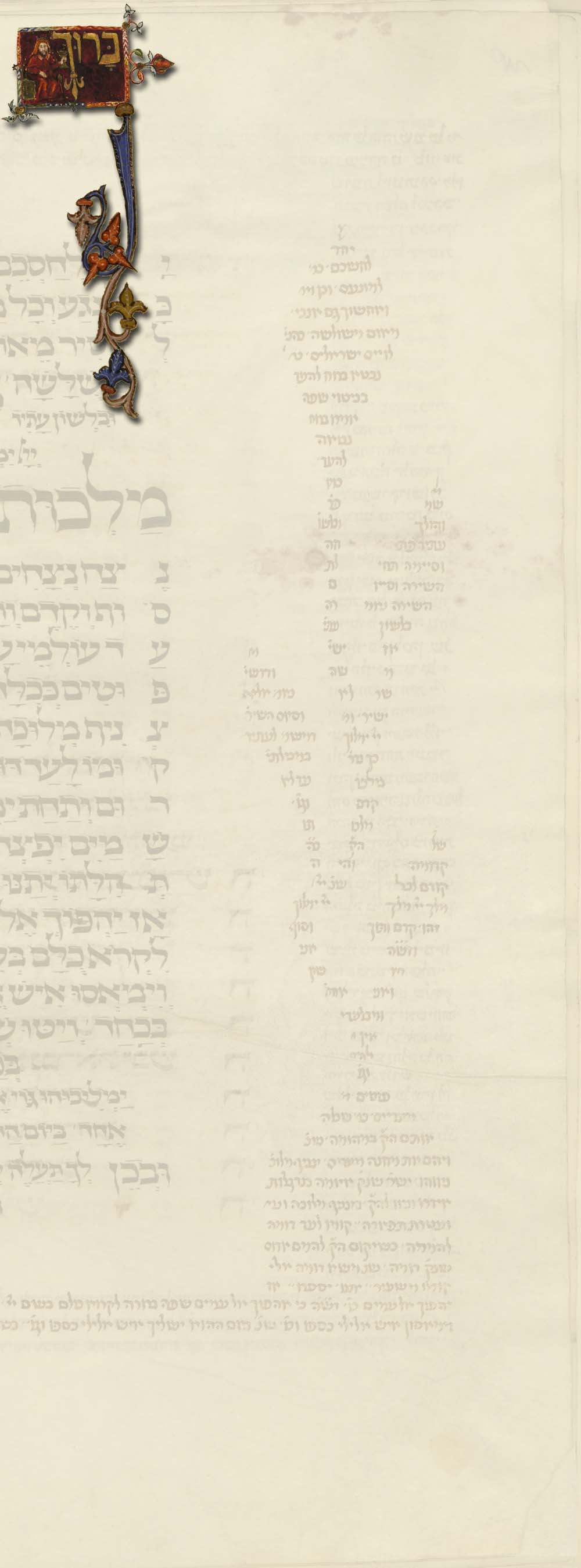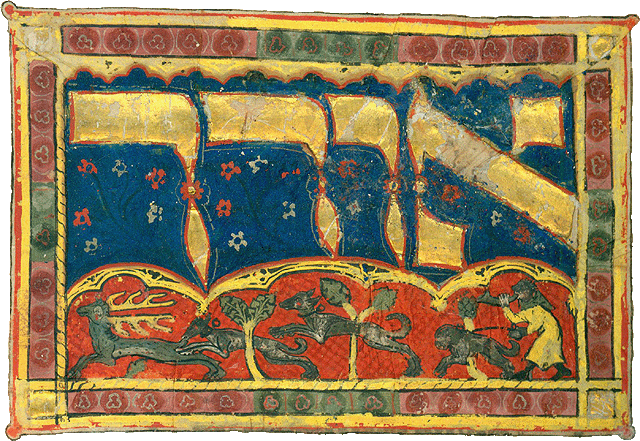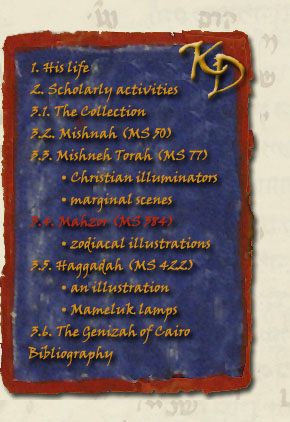



 3.4.
Tripartite Mahzor
3.4.
Tripartite Mahzor
(MS A 384)
The Mahzor shelf-mark A 384 contains many exciting illustrations, the details of which have not yet been sufficiently researched. This manuscript was written in Southern Germany (in the region of Lake Constance, Bavaria or the region of the Upper Rhine) around 1320. 146 It is also called “Tripartite Mahzor” because Bezalel Narkiss has shown convincingly that it is in fact volume I of a sizeable manuscript consisting of three volumes. The two remaining volumes are preserved in the British Library in London and in the Bodleian Library in Oxford. 147 An interesting characteristic of the manuscript is that human female figures generally appear with animals' heads. The adoption of animals' heads occurs in illuminated manuscripts produced in France and Germany in the 13-14th centuries but the general habit is to represent all human figures, male and female alike, in this way – in contradistinction to our manuscript. 148 There is no universally accepted explanation for this peculiarity. Joseph Gutmann writes:
Most scholars feel that it is attributable to an iconophobic tendency in contemporary German Jewry; one scholar claims that these characteristics are caricatures traceable to the medieval stage; others are convinced that they represented godly grace – elevation above the human. None of these theories is satisfactory, since the evidence of the miniatures contradicts the various hypotheses. In the mystical literature of the circle that gathered around the twelfth-century Judah he-Hasid (Judah, the Pious), we do find mention of dog-headed and bird-beaked human beings. The whole problem needs further study. 149
One of the visitors to our Collection, Ruth Mellinkoff, came to the conclusion during her recent researches that what in fact lies behind the representation of women with the heads of animals – and mainly those considered repulsive in the contemporary imagination – are anti-Jewish feelings of Christian illuminators, who resorted to hidden iconographic allusions which Jewish patrons would not comprehend.

146 On this manuscript see Gabrielle
Sed-Rajna: Le mahzor
enluminé. Les voies de formation d'un programme iconographique.
Leiden 1983. 16-17, 47-48, 71-72.
Narkiss – Sed-Rajna 1988. Tripartite Mahzor, vol. I. Card No. 41.
Kaufmann purchased the
manuscript from antiquarian bookseller
Rabinowitz (Munich) in 1883.
147 Bezalel
Narkiss: A tripartite
illuminated Mahzor from a South German school of Hebrew illuminated
manuscripts around 1300. In: Fourth World Congress of Jewish
Studies [Jerusalem 1965]. Papers. Jerusalem 1967-1968. II. 129-133.
A student of Narkiss has
now prepared a thorough analysis of the whole manuscript; Sarit
Shalev-Eyni:
Ha-Mahzor ha-mešullaš [=The Tripartite Mahzor]. PhD thesis.
Jerusalem 2001. (It was not used in the preparation of this paper.)
148 See, e.g., the so-called
Bird's head Haggadah (Israel Museum, Jerusalem, Ms. 180/57), so
called because the human figures in it appear mostly with birds' heads.
The manuscript was written in Southern Germany around 1300.
149
Gutmann 1978. 25-26. See
also Cohen 1988. 49. Ruth
Mellinkoff 1999. 11.
Narkiss 1967-1968. 133.
Heinrich Strauss: Die
Kunst der Juden im Wandel der Zeit und Umwelt. Tübingen 1972. 56-62.
Joseph Gutmann: The
illuminated medieval Passover haggadah: investigations and research
problems. In: Studies in Bibliography and Booklore 7 (1965) 8
[offprint].
150
Réau 1955-1959. I. 131.
151 Müller
– von Schlosser: Bilderhaggaden 1898. 136, 157, Tafel XIX.
von Schlosser:
Bilderschmuck 1898. 236.
Kaufmann: Bilderzyklen. In:
Kaufmann 1908-1915. III. 235-240.
Bezalel Narkiss –
Gabrielle Sed-Rajna:
Index of Jewish art. Volume II/2 (1978). The Second Nürnberg
Haggadah. München – New York – London – Paris 1981. Cards No. 35, 118.
152
Metzger 1973. 3508:
les tabernacles gothiques selon le mot de Müller-Schlosser et de
Kaufmann.
153 Lexikon der christlichen
Ikonographie 1968-1976. I. 240 [s.v. Ciborium, Baldachin].
154
Mellinkoff 1999. 35-42
(Chapter Five: Animals with negative connotations), 56-57.
155
Müller – von Schlosser:
Bilderhaggaden 1898. 114, 117 [=Weisz
1906. 124, 125]. Narkiss –
Sed-Rajna 1988. Tripartite Mahzor, vol. I. Card No. 8.
Sed-Rajna doubts that the
manuscript could be closely connected to this special battle
nevertheless she agrees too that the manuscript is likely to have been
produced around the date suggested.
Sed-Rajna 1983. 16-17, 48.
156
von Schlosser:
Bilderschmuck 1898. 235.
157
Réau 1955-1959. I. 126.
158 Lexikon der christlichen
Ikonographie 1968-1976. IV. 134-136, esp. 135.
159
Fingernagel – Haidinger 2002. 34.
 In places one must at least doubt that
they would not have comprehended these allusions. It is hardly believable, for
instance, that pious Jews would not have been upset by the representations of
wild boars in the so-called Second Nürnberg Haggadah (f.7r, f.27r). The
interpretation of these scenes is controversial. In so far as one of the wild
boars is carrying a device reminiscent of a tabernacle (in the Christian sense
of the word) while the other is standing on the top of such a device inside
which is seated the head of the family leading the festive ritual, they might
symbolize the victory of good over evil, but it is equally possible that they
are no more than simple decorations inspired by sudden whims of the illustrator.
In places one must at least doubt that
they would not have comprehended these allusions. It is hardly believable, for
instance, that pious Jews would not have been upset by the representations of
wild boars in the so-called Second Nürnberg Haggadah (f.7r, f.27r). The
interpretation of these scenes is controversial. In so far as one of the wild
boars is carrying a device reminiscent of a tabernacle (in the Christian sense
of the word) while the other is standing on the top of such a device inside
which is seated the head of the family leading the festive ritual, they might
symbolize the victory of good over evil, but it is equally possible that they
are no more than simple decorations inspired by sudden whims of the illustrator.
 In any case, the pig has negative connotations in mediaeval Christian art in
general: it is the symbol of gluttony and materialism. 150
The background for the choice of this tabernacle- or monstrance-like device is
not clear either; it appears quite often in this manuscript and at times it is
placed on the back of various animals and mythological creatures. In addition,
quite a number of similar turret- and castle-like devices appear in various
places in this manuscript, and King Solomon's throne is of similar structure
too. Consequently, the use of this device as a motif of ornamentation need not
necessarily be attributed to a deeper meaning related to the role of the
tabernacle and the monstrance in the Roman Catholic Church, but may be rooted
simply in the ornamentational vocabulary of the artist. We cannot be quite sure
of this, though. This tabernacle also appears in other manuscripts of German
origin: Kaufmann terms it “the favourite decoration of the German Haggadah”
(diese Lieblingsdekoration der deutschen Haggada), which occurs in most
representations of liturgical acts deserving special emphasis.
Narkiss and
Sed-Rajna use the neutral
expression “architectural framework.” 151
Metzger also mentions this motif
listing it under the motif of canopy (baldachin) without comment. 152
In general, a tabernacle marks off a space of special rank, of pre-eminent
importance. 153
In any case, the pig has negative connotations in mediaeval Christian art in
general: it is the symbol of gluttony and materialism. 150
The background for the choice of this tabernacle- or monstrance-like device is
not clear either; it appears quite often in this manuscript and at times it is
placed on the back of various animals and mythological creatures. In addition,
quite a number of similar turret- and castle-like devices appear in various
places in this manuscript, and King Solomon's throne is of similar structure
too. Consequently, the use of this device as a motif of ornamentation need not
necessarily be attributed to a deeper meaning related to the role of the
tabernacle and the monstrance in the Roman Catholic Church, but may be rooted
simply in the ornamentational vocabulary of the artist. We cannot be quite sure
of this, though. This tabernacle also appears in other manuscripts of German
origin: Kaufmann terms it “the favourite decoration of the German Haggadah”
(diese Lieblingsdekoration der deutschen Haggada), which occurs in most
representations of liturgical acts deserving special emphasis.
Narkiss and
Sed-Rajna use the neutral
expression “architectural framework.” 151
Metzger also mentions this motif
listing it under the motif of canopy (baldachin) without comment. 152
In general, a tabernacle marks off a space of special rank, of pre-eminent
importance. 153
The fact that only women and not men were portrayed with animals’ heads can in Ruth Mellinkoff’s view be explained by the fact that in mediaeval Germany men wore the pointed Jewish hat as a disreputable badge while women did not, so the artist portrayed them with the heads of disreputable animals instead. 154 She detects similar hidden anti-Jewish sentiments in an important illumination (f.103v) displaying in the upper margin a grotesque, perhaps a clown, exhibiting his naked hindquarters in an indecent way. It was mainly on the basis of this illustration, incidentally, that this manuscript could be dated: the figures of the two knights are no doubt an allusion to the battle of Mühldorf, which took place on 28 September 1322 between Frederick the Fair and the friend of his youth, Louis of Bavaria – the arms of Austria and Bavaria appear on the caparisons of the mounts. 155 However, the two fighting knights are also known in Christian art as the representations of the spiritual struggle between righteousness and evil, as illustrated in Psalm I. 156 It is possible that similar anti-Semitic sentiments may also lie behind the frequent occurrence of the representation of the owl in margin illustrations in the Kaufmann Haggadah: in Christian manuscripts the owl is the symbol of the Jews, who – just like the birds of the night – prefer the darkness of evil and sin to the light of the Gospel. 157 Similarly, the occurrence of pigs in certain manuscripts such as the Second Nürnberg Haggadah may bear more or less hidden anti-Semitic connotations: the pig is the symbol of evil, the devil, the sinner, uncleanness, immoderateness, gluttony, unchasteness and wrath. In the 13th century, with the emergence of anti-Semitism, it occurs in Christian art for the first time as the symbol of the Jews, too. 158
Our interpretation of this phenomenon receives a considerably more differentiated background and gains in depth if we consider the situation displayed by the Hebrew manuscript in the National Széchényi Library already referred to above (Sefer Mordechai). In this remarkable manuscript some heads appear in the marginal ornamentation which lend themselves to such an interpretation although such an interpretation is by no means cogent. Now, the heads in question constitute only a tiny minority of the eighty-four (or eighty-five) heads appearing in the manuscript altogether. Other – Christian – manuscripts illuminated by the same artist are known from Lower Austria and similar heads appear there also, this time with bishops’ mitres and monks’ tonsures. Consequently if we interpret his drawings as caricatures then we must admit that our artist was not selective in his dislike: he was equally critical of Christian clerics also. 159 Another aspect of this manuscript is worth mentioning in this context. A few of the heads referred to are placed upside down. This strange phenomenon has been interpreted as a result of the Christian artist’s ignorance of the correct position of the leaves owing to his ignorance of the Hebrew script. As we have shown above, this is out of the question because the general structure of the ornamentation leaves no doubt that the artist was familiar with the correct position of the leaves and he never made mistakes in this respect. Rather, this phenomenon is to be attributed to his playful mind, which tried to lift the boredom of long and tedious working hours with such childish jokes. However, another idea comes to mind also. It has been recorded that in modern states, after great political changes, when for some reason it was impossible to issue new stamps with the portrait of the new ruler, or, in the case of the collapse of a monarchy, with the emblems of the new republic, the old stamps were retained for a while but they had to be put on the envelopes upside down, otherwise they were not valid. So one may ask himself, whether in our case the strange position of the heads could be a source of humour or derision?
